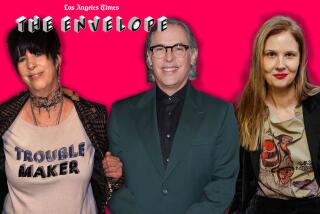Toots Thielemansâ Life of Making Music
The Belgian-born musician Jean (Toots) Thielemans is unique. He is the only man on earth to have become reasonably rich and famous with his particularly odd trilogy of talents: He plays the harmonica. He whistles. He plays the guitar.
He also composes. His âBluesette,â which he whistled on a 1961 record in Stockholm, became one of the most famous of all jazz waltzes; at least 100 artists have recorded it.
He is in the news at the moment: His record âOnly Trust Your Heartâ (Concord CCD 4355) is the first album he has made as a leader in a dozen years, and he has been on tour, playing clubs in the United States. âMy wife calls this my jazz vacation,â he said the other day during a break between sets at Catalina Bar and Grill in Hollywood.
While his tour may not be a vacation, it is a break for Thielemans. He has devoted much of his time in recent years to pursuits far more profitable than jazz. âWhistling for jingles is very lucrative,â he said.
The Good Life
Jobs at that elevated level have enabled him to lead the good life, with two homes, a farmhouse outside Brussels and an East Side New York apartment. His stature is the more remarkable in view of his sickly childhood and a late and tentative start.
âI played accordion as a kid, but never took music seriously. It wasnât until I had seen the Harmonica Rascals in a movie, and heard a couple of Larry Adler records, that I found out there was such a thing as a harmonica. I was at Brussels University, suffering from asthma and generally poor health, and I was studying to become a math teacher.â
He played the harmonica for kicks, still with no serious ambitions. During another illness--he was in bed with pneumonia--a friend brought him a guitar.
âBy that time I was 20 and listening to Django Reinhardtâs records. It wasnât until after the liberation that I hung out with GIs and American officers, playing dance music for the soldiers.â
America was on his mind; he even took an American nickname. âI knew there was a sax player with Benny Goodman named Toots Mondello, and this sounded hipper than Jean, so it stuck.â
On Thielemansâ first visit to the United States in 1948, during the dying days of 52nd Street, he sat in with Lennie Tristano and others.
An acetate record he made privately came to the attention of the trumpeter Ray Nance, who was visiting Europe with Duke Ellington. âRay took the record to an agent in New York, who called me and said, âI want to bring you to the States and call you âthe Belgian King of Bebop!â He wanted to put me with Benny Goodman, who was going through a bop phase, but my permit never came through. I did wind up working with Benny, though, when he toured Europe in 1950.â
The following year he emigrated to America, and for a while, the pickings were slim. âI tried to go the commercial route in a trio with harmonica, organ and banjo. It flopped, and I really scuffled until Tony Scott, the clarinetist, recommended me to George Shearing.â
Thielemans auditioned for Shearing, playing solo harmonica backstage at Carnegie Hall. âI just played âBody and Soulâ and I guess he heard the musicianship, because he said if I could play the guitar parts, heâd hire me.â
Shearingâs next chance to hear Thielemans came about when the Belgian musician was booked to play a week at the Earle, a black theater in Philadelphia. âDinah Washington topped the bill. In second billing were the Charlie Parker All Stars, with Miles Davis, Milt Jackson, a rhythm section, and me on harmonica. Hearing me that week satisfied George, and he began teaching me the guitar parts.â
Touring for six years with the Shearing Quintet, playing mainly guitar but always featured in a harmonica specialty, Thielemans became entrenched in the American jazz community, recording with various groups of his own as well as with Shearing. âToots was one of the most versatile and inspiring musicians Iâve ever worked with,â Shearing said recently. âBut it wasnât until after he left me that he began that routine of playing guitar and doubling the melody an octave higher by whistling.â
That device proved to be a true turning point in Thielemanâs career. On a visit to Sweden, where he had long been popular, he decided to record âBluesette.â âI went into a studio and started to rehearse it on harmonica, but the producer said, âToots, thatâs a pretty song. Why donât you try to whistle it and play it on guitar?â â
The record became an international hit; soon Thielemans was in constant demand. Starting in 1963, he was a staff musician at ABC-TV in New York. Later in the 1960s and throughout the â70s he played on several movie sound tracks (âMidnight Cowboy,â âSugarland Expressâ) and began a long, close association with Quincy Jones.
There were live jazz festival recordings with Dizzy Gillespie and Oscar Peterson at Montreux, and a studio date (âAffinty,â Warner Bros.) with Bill Evans, of whom he has especially fond memories. Another perennial admirer of Bill Evans is the pianist Fred Hersch, whom Thielemans credits with luring him back to jazz recording after a decade-long absence. âI was financially secure, and Iâd made a couple of records that I wasnât too proud of, but Fred kept pushing me, and after a couple of years I finally did it. Iâm glad, too, because itâs a good statement of what I am and where I am today.â
More to Read
The biggest entertainment stories
Get our big stories about Hollywood, film, television, music, arts, culture and more right in your inbox as soon as they publish.
You may occasionally receive promotional content from the Los Angeles Times.










